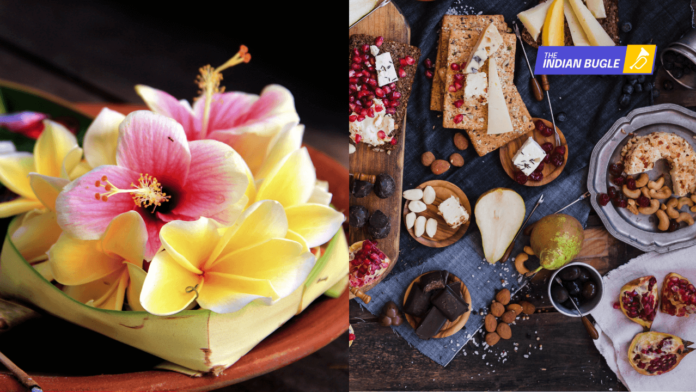Goddess Durga is revered as the Mother of the Universe, the embodiment of Shakti, and the destroyer of negativity. Devotees believe that sincere offerings made to her during puja not only please the goddess but also bring prosperity, strength, and protection. Each item — whether a flower, fruit, or bhog — carries symbolic meaning and is considered sacred when offered with devotion.
Why Offerings Matter
Offerings (puja samagri) represent love, surrender, and gratitude. Flowers express beauty and purity, fruits stand for abundance, bhog symbolizes nourishment, while incense and lamps invite positivity. More than the ritual itself, it is the devotion and purity of heart that make these offerings meaningful.
Flowers to Offer to Goddess Durga
Flowers are central to Durga Puja. Traditionally, bright and red flowers are preferred as they symbolize Shakti (power) and energy.
- Red Hibiscus (Gudhal) — the most beloved flower of Goddess Durga, representing strength and divine energy.
- Rose (red or pink) — symbolizes love and devotion.
- Lotus (white or pink) — purity and spiritual awakening.
- Marigold — associated with auspiciousness and widely used in garlands.
- Jasmine (Mogra) — for its fragrance and purity.
- Chrysanthemum — often used during Navratri rituals.
Tip: Always offer fresh, whole flowers, never dried or wilted ones.
Fruits to Offer to Goddess Durga
Fruits are considered natural and sattvic (pure), making them an ideal offering.
- Banana — considered very auspicious and a common offering to the goddess.
- Coconut — symbol of purity and the breaking of ego; often kept on the kalash during puja.
- Apple, Pomegranate, Mango, Grapes — signify abundance and sweetness in life.
- Wood-apple / Bel fruit — used in some traditions as a special offering.
- Dry fruits (Panchmewa) — a mix of five dry fruits like almonds, cashews, raisins, pistachios, and walnuts, offered for good health and longevity.
Always ensure fruits are fresh, washed, and neatly arranged on a clean plate or banana leaf before offering.
Bhog / Prasad for Goddess Durga
Bhog or prasad offered to Durga varies across regions and traditions, but some items remain universally loved.
- Kheer (sweet rice pudding) — milk-based, simple, and considered highly auspicious.
- Halwa (semolina or lentil-based) — rich and nourishing.
- Malpua — a sweet delicacy often prepared for the goddess.
- Puri and Ladoo — frequently used in bhog thalis.
- Kachori and other fried items are traditional in many communities.
- Panchmewa (mixed dry fruits) — considered a special prasad.
- Milk, curd, ghee, sugar, and honey — five pure items often used together in rituals.
During Navratri, each form of Goddess Durga is associated with a special bhog — for example, coconut halwa for Mahagauri or malpua for Kushmanda.
Other Sacred Items to Offer
Apart from flowers, fruits, and bhog, devotees also present sacred items that symbolize purity and devotion:
- Sindoor / Kumkum and Turmeric — sacred powders for blessings.
- Sandalwood paste (chandan) — cooling and purifying.
- Diyas (ghee lamps) — symbolize light over darkness.
- Incense sticks and dhoop — fragrance to purify the surroundings.
- Red cloth (chunri) or saree — offered to the goddess, symbolizing power and respect.
- Betel leaves and supari are considered auspicious.
- New clothes and food for Kumari Puja — little girls are worshipped as a form of Durga and offered bhog and garments.
How to Present the Offerings
- Use a clean thali or banana leaf.
- Arrange flowers, fruits, and bhog neatly.
- Light a ghee diya and incense before offering.
- Offer everything with folded hands and recite Durga mantras or simple prayers.
- After puja, distribute the offerings as prasad among family and guests.
Final Thoughts
Whether you offer a single hibiscus flower or an elaborate thali with kheer, fruits, and sweets, what matters most is devotion. Goddess Durga accepts offerings made with a pure heart and blesses her devotees with courage, health, prosperity, and protection.
